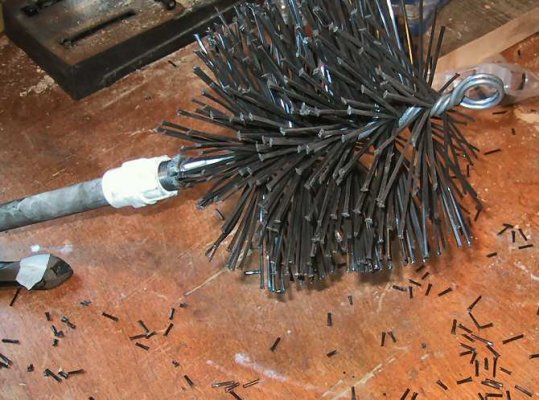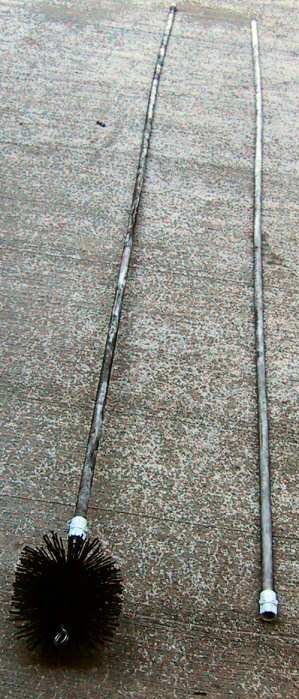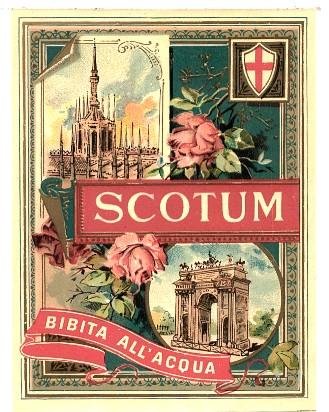TromboneAl
Give me a museum and I'll fill it. (Picasso) Give me a forum ...
- Joined
- Jun 30, 2006
- Messages
- 12,880
Just cleaned my chimney for the first time, and it was quite easy, once I got the bugs out. Thought I'd pass on what I learned.
Last year I asked the chimney sweep how to do it. He told me: "Sweep the brush down the flue (metal), and scoop out the creosote that will land here (on the smoke shelf)." On my system, the top of the chimney is easily accessible, and the design of my woodstove-like fireplace lends itself to easy cleaning (for some you have to do some disassembly).
I kept my eye out at garage sales and finally found a chimney brush (new) for $1. Next I had to get the interconnecting rods. Those cost $5 each, and I'd need 5 for the 20 foot length of my chimney. So instead, I got two 12 foot lengths of PVC pipe, along with the appropriate fittings to be able to glue everything together. Total cost incl brush: $8.68.
Next, it was up to the rooftop. I found that the chimney cap (spark arrestor) just popped off, and I was ready to go. I put the brush in and it immediately got stuck. Not surprising, since the brush was for an 8" flue, and I had a 7" flue. It took a while to dig it out.
So at that point I could have gotten in the car and driven 25 miles to the hardware store and purchased a 7" brush for $22. But instead, I reasoned that it would be faster and cheaper to cut one half inch off of all the (500) bristles (they were plastic). I taped a little guide on my wire cutters and about 45 tedious minutes later I was ready to go back up on the roof.
The brush was still a tight fit, but it worked.
At this point I simply pushed the brush down through the chimney. When it got half way down, I screwed on the second PVC pipe and pushed it the rest of the way. Each time I'd pass the connections between different sections of flue it would make a different noise.
I had DW in the living room with a walkie-talkie to tell me whether any dust was coming out, but there was none.
Finally I felt it pass out the bottom of the flue. I then pulled it back up. I did this twice. The part of the flue that I could see was 100% clean, so I decided that was enough, and cleaned off the cap and put it back on.
Down in the living room I scooped out the creosote that had accumulated on the smoke shelf. This involved reaching in there with a trowel, and putting the creosote into a paper bag for the compost. This was less messy than expected, though I'd recommend a dust mask.
I cleaned up and put things away. That was all there was to it.
I figure I'll do this each year, but every third year have a chimney sweep inspect it.
Last year I asked the chimney sweep how to do it. He told me: "Sweep the brush down the flue (metal), and scoop out the creosote that will land here (on the smoke shelf)." On my system, the top of the chimney is easily accessible, and the design of my woodstove-like fireplace lends itself to easy cleaning (for some you have to do some disassembly).
I kept my eye out at garage sales and finally found a chimney brush (new) for $1. Next I had to get the interconnecting rods. Those cost $5 each, and I'd need 5 for the 20 foot length of my chimney. So instead, I got two 12 foot lengths of PVC pipe, along with the appropriate fittings to be able to glue everything together. Total cost incl brush: $8.68.
Next, it was up to the rooftop. I found that the chimney cap (spark arrestor) just popped off, and I was ready to go. I put the brush in and it immediately got stuck. Not surprising, since the brush was for an 8" flue, and I had a 7" flue. It took a while to dig it out.
So at that point I could have gotten in the car and driven 25 miles to the hardware store and purchased a 7" brush for $22. But instead, I reasoned that it would be faster and cheaper to cut one half inch off of all the (500) bristles (they were plastic). I taped a little guide on my wire cutters and about 45 tedious minutes later I was ready to go back up on the roof.
The brush was still a tight fit, but it worked.
At this point I simply pushed the brush down through the chimney. When it got half way down, I screwed on the second PVC pipe and pushed it the rest of the way. Each time I'd pass the connections between different sections of flue it would make a different noise.
I had DW in the living room with a walkie-talkie to tell me whether any dust was coming out, but there was none.
Finally I felt it pass out the bottom of the flue. I then pulled it back up. I did this twice. The part of the flue that I could see was 100% clean, so I decided that was enough, and cleaned off the cap and put it back on.
Down in the living room I scooped out the creosote that had accumulated on the smoke shelf. This involved reaching in there with a trowel, and putting the creosote into a paper bag for the compost. This was less messy than expected, though I'd recommend a dust mask.
I cleaned up and put things away. That was all there was to it.
I figure I'll do this each year, but every third year have a chimney sweep inspect it.





 Ild rather pay the $155 bucks.
Ild rather pay the $155 bucks.